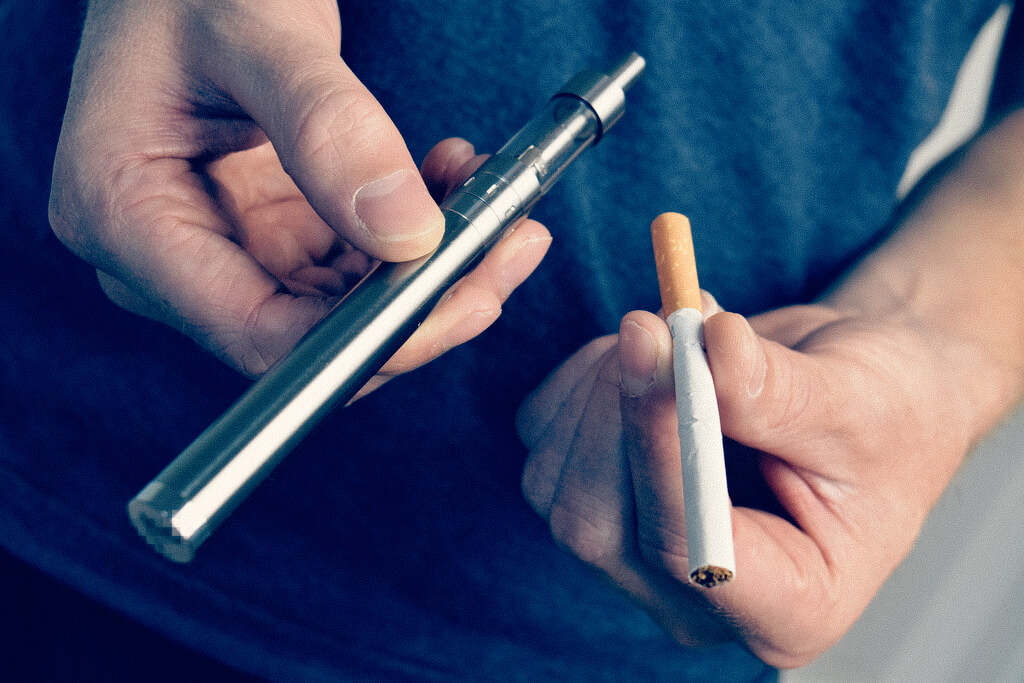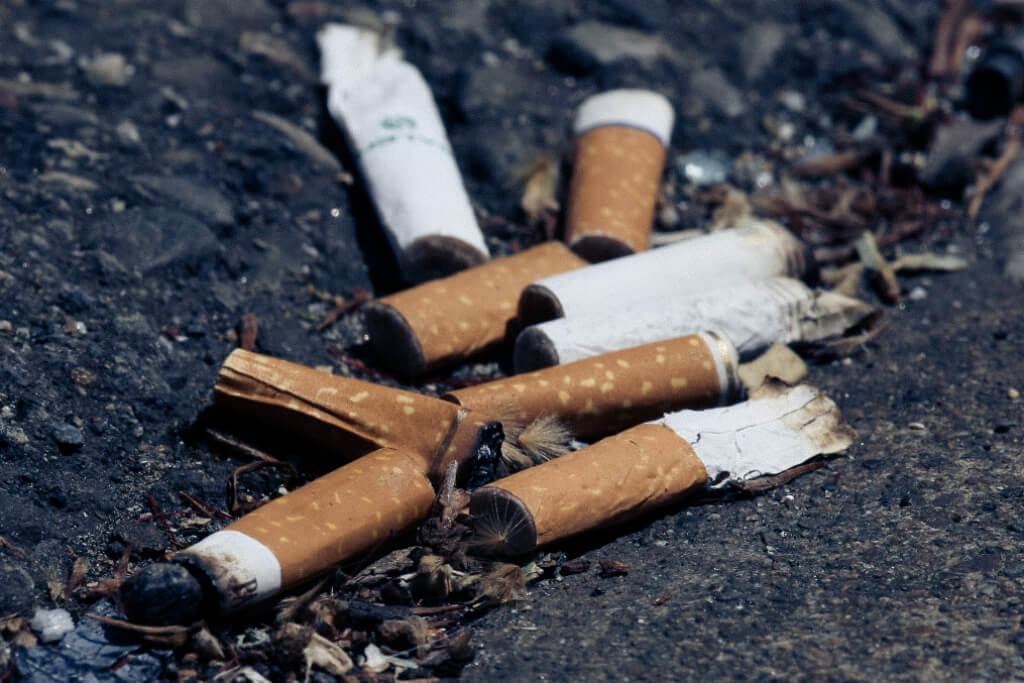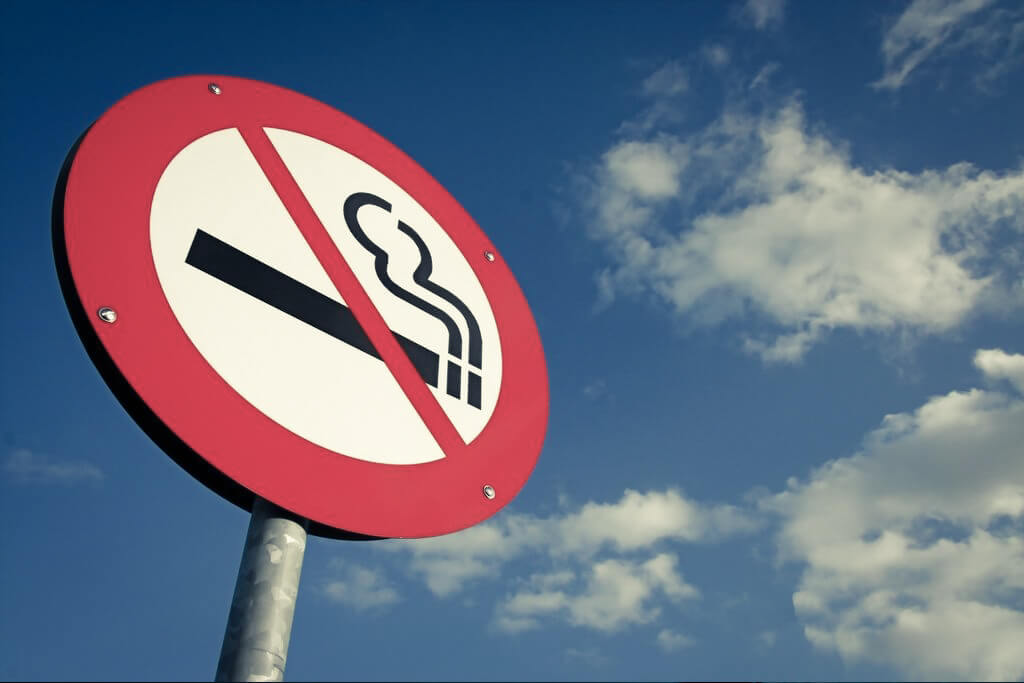Though the idea for the e-cigarette was first documented in 1927, a working smokeless cigarette was first produced in 1963, but that wasn’t the start of the vaping revolution. The first commercially viable electronic cigarette was manufactured in China after being invented by pharmacist Hon Lik in 2003. Since then vaping has become more and more popular, but with its relatively short time on the market, research is just becoming available comparing the health impact of vaping as opposed to smoking. In addition to emerging science and research, there is much that we can assume, just based on our understanding of the chemicals in cigarettes and in vaping fluids and how those chemicals react in the body.
Smoking has become the health boogeyman in recent times with states and individuals winning large settlements from the tobacco industry for their concealment of the adverse side effects as well the fact they were putting additives into their products to increase users dependency upon cigarettes. This has made the public, health agencies, and government regulating bodies, very leery of any product that enters the cigarette market. Some have suggested even big tobacco has tried to create confusion about the safety of cigarettes and vaping devices, though many now have entered the e-cigarette market themselves.
In this article, we will try to demystify the issue and look at all of the data available on both cigarettes and vaping devices and provide you with the available facts to help you decide which product is safer and more appealing to you.


The Harmful Chemicals Associated with Vaping Vs Smoking
Currently, smoking is considered the number one cause of preventable deaths around the world. Smoking’s adverse health effects aren’t just because of the tobacco leaves used in cigarettes, but because of the many chemical additives. Governments around the world have now started regulating cigarette ingredients to help reduce the adverse health effects of smoking. Currently, e-liquids are regulated by the same health agencies that regulate cigarettes, and the same chemicals and additives that aren’t allowed in cigarettes are also not allowed in vaping e-juice. That said there are still a large number of ingredients in vaping fluids that are different from what you would find in cigarettes, largely attributed to flavorings used in vaping e-liquids. There are also a number of ingredients you will find in a cigarette that you will not find in vaping e-juices, in fact, these ingredients are so numerous we can list them all here, but we will list the ones that are most concerning:
Formaldehyde: The national cancer institute has concluded from its studies that formaldehyde likely causes leukemia as well as other cancers in humans. People sensitive to formaldehyde might experience a cough, sore throat, nose bleeds, and itchy eyes if exposed to too much formaldehyde. Formaldehyde is in cigarettes and second-hand smoke. There has been a study that showed formaldehyde could be produced using a vaping device, but when used correctly vaping devices used at low wattages will not produce formaldehyde, and it is not an ingredient in vaping fluids.
Lead: Most people have heard of lead and know that it causes brain damage and behavioral changes. Many people aren’t aware that you can find lead in cigarettes, but even scarier is that you can find lead in second-hand smoke, which is especially dangerous when children are exposed. There has been some research suggesting that there is lead associated with e-cigarettes as well, but this seems to come from the heating coils and affects only some devices. Better manufacturing of vaping devices could eliminate the risk of lead associated with vaping.
Cyanide: Though cyanide isn’t an ingredient that is added to cigarettes when burned cigarettes do produce hydrogen cyanide, which is a poison. The cyanide in cigarettes is both in the smoke that the user inhales as well as the second-hand smoke that is breathed in by those in close vicinity to the smoker. The effects of cyanide include headaches, dizziness, weakness, nausea, and vomiting.
Arsenic: Cigarettes end up with arsenic in them due to the pesticides used in growing tobacco, and though the quantities are small, arsenic is known to cause cancer. Just like with all of the other harmful ingredients we have talked about arsenic is found to affect both the smoker and those exposed to second-hand smoke. There is concern that some devices used in vaping may also emit arsenic, but this is possibly something that can be eliminated through better design of vaping devices and is not present in vaping e-juice.
Ammonia: Tobacco manufacturers have added ammonia to their products to help make the nicotine more potent. Ammonia can cause lung damage and will irritate and even burn eyes, nose, throat and the respiratory tract. Ammonia is also present in second-hand smoke.
Tar: A by-product of the burning tobacco leaves, tar causes lung damage and contributes to lung diseases like emphysema and chronic bronchitis. It is also the substance that turns your teeth brown and stains your fingers. Tar will not only be found in the second-hand smoke, but it lands on surfaces, which then can expose children and others who are around smokers and smoky environments to more tar exposure. Vaping does not produce tar.


These are just a few of the dangerous ingredients found in cigarettes. Though some recent research has also found some of these ingredients are also associated with vaping, the concentrations in vaping are much lower and may only occur when used in faulty vaping devices. Looking at the differences in harmful chemicals contained in cigarettes and vaping fluids, it seems clear that there are significantly fewer harmful chemicals and lower levels associated with vaping.
Many of the ingredients found in vaping fluids are food grade and are regarded as safe. There is still research that needs to be done into harmful metals, chemicals, and by-products associated, but at the moment there is no research that suggests that these harmful components are higher in vaping units than cigarettes. Overall if you want to lower your exposure to toxic chemicals, vaping seems to be the hands-down winner.


Addiction; is Vaping better than Smoking: In both cigarettes and vaping, e-liquids nicotine is the primary addictive ingredient. People like this drug because it is a stimulant and can help them feel more alive, awake and give a momentary sense of euphoria. Nicotine is the ingredient that people get addicted to.
One of the main reasons that the government has won large monetary settlements from tobacco companies is the intentional engineering to make cigarettes more addictive. Cigarette manufacturers have added ammonia, acetaldehyde, bronchodilators, and levulinic acid to make cigarettes more addictive and easier to smoke. Even over the last couple decades when the risks associated with smoking became widely recognized, tobacco companies have continued to tweak their products to make people who use them more reliant upon them, more quickly.
The manufactures of vaping fluids have steered clear of purposefully making their products more addictive and have even made it easier for users to control the amount of nicotine that they consume. This has lead to vaping devices used being used for smoking cessation, and some doctors have recommended smokers switch to vaping if they have had trouble quitting smoking using traditional methods. Every major brand of e-cigarettes and vaping fluids have zero nicotine products, suggesting that many people who are vaping are doing so to get away from nicotine addiction.
Traditional smoking cessation programs fail 95% of the time, but 31% of vapers manage to completely stop using cigarettes within 6 months. Of those who manage to stop using cigarettes, 34% stop using all nicotine products. In teens that start vaping, there is research that shows they are occasional social users, who never develop a true nicotine addiction. Studies on teens that start smoking cigarettes indicate they quickly become addicted and dependent upon cigarettes.
Though never smoking is ideal, over and over vaping has been demonstrated to not only be less addictive than cigarettes, but has shown that it can aid in ending addiction.


Cost of Vaping vs Smoking
The cost of a pack of cigarettes depends largely on where you live. For example:
- Las Vegas $7
- New York $13
- Los Angeles $8
- Seattle $9
- Chicago $12
If you use an average cost per pack of $9, based on the average smoker going through 5 packs a week that makes the average cost of cigarettes around $195 per week, which is an expensive habit. Assuming that a vaper will spend $100 per year on a vaping device and $15 on average for vaping juice, you have a cost of $74 per month. Hands down vaping is far less expensive than smoking


Safety is Vaping Better than Smoking?
Cigarettes and lighters account for more than 100,000 fires per year which cause 300 to 400 deaths. Since vaping devices have become popular on the market, there have been no fires that have resulted in the loss of life. The fires that have occurred are usually caused by defective batteries in the vaping devices, and the occurrence is similar to what is seen with cell phones and other battery powered devices.
Vaping e-juice is highly concentrated, and if the juice is consumed outside of a vaping unit, the potential for poisoning is very high. Even when a child gets into a pack of cigarettes, it is unlikely they will be able to get a high enough dose of nicotine to endanger their lives. Nicotine gum and patches pose a higher risk to children, but vaping juice does pose the highest risk. Since vaping juice has come on the market, there has been a significant increase in the number of children who ingest a dangerous or lethal dose. That said, in 2013 there were a total of 1,543 cases of nicotine poisoning from all sources of nicotine. Compare that to 196,186 cases of poisoning from cleaning products.
Overall in researching this article, we could not find any documented cases of someone dying from accidental nicotine poisoning, so though it is a severe problem the real safety issue is with the number of deaths caused by cigarette fires. Even factoring in the higher instance and risk of nicotine poisoning, vaping is safer than cigarettes.


Environmental Consequences of Smoking and Vaping
Smoking is a dirty habit, and by dirty, we mean that it creates a lot of trash. Cigarette filters are the most common form of trash throughout the world. You will find cigarette butts at beaches, along roadways, littering parks and just about anywhere you find people, even in pristine protected habitats. Businesses, government offices, and public spaces all put considerable resources into creating places to dispose of cigarettes safely.
With vaping, you use a cartridge, some of which are recyclable, and these cartridges have not been showing up as a common litter item even as vaping becomes more popular.
There are a million trees per year cut down for the manufacture and packaging of cigarettes. Cigarette butts and trash introduce arsenic, lead, formaldehyde and other toxins into the environment. Contaminates from cigarettes have been found in water with sensitive marine life as well as sandboxes where children play. Numerous environmental groups would like cigarette butts declared toxic waste due to their high level of toxins.
Some have argued that the petroleum products used in the plastics to make vapes and vape cartridges create a higher environmental impact than the wood consumption used in cigarettes. That assertion is at this point only a hypothesis as cigarettes also use petroleum for the cellophane that they use in cigarette packaging. Getting deeper into the carbon footprint arguments, the compact size and weight of a vaping cartridge are significantly smaller than what is needed to get the same amount of nicotine from cigarettes, so for all intents and purposes, it seems that the petroleum usage is about the same.
There is some hazardous waste with vaping, and that is in the disposal of vaping devices because of the batteries, but it seems most people are disposing of vaping devices like they would other battery operated devices. These devices are not appearing outside of the normal electronics trash stream. Overall the amount of waste and environmental impact is lower with vaping devices than cigarettes.


Adverse Health Effects of Smoking compared to Vaping
As discussed before the active addictive ingredient in both cigarettes and vape juice is nicotine. Nicotine does cause heart and cardiovascular disease. Many other toxins have been found to be in both cigarettes and vaping; however, these toxins are 9 to 450 times lower in vaping products. If you are looking for options that have the fewest amounts of toxins, you will want to stay away from e-cigarettes made by large tobacco companies and go with a vape pen or vape mod.
There is a lot of well-documented evidence that cigarettes are harmful and that second-hand smoke is harmful. Over and over vaping devices have been shown to have a significantly reduced risk when compared to cigarettes both for the user and those who are exposed to second-hand smoke or second-hand vape.
Even though the reduced risk is well documented and well-studied, there are plenty of people who have raised concern and alarm over possible risks that are unique to vaping or greater with vaping. The problem is even when risks are confirmed; the risk of vaping has, so far, always been lower. All of the other risks and concerns that have been raised are hypothetical and have not been backed up with research.
Even concerns with some of the flavorings found in vaping fluids, especially the idea these flavorings could cause diseases like popcorn lung, have just borne out. In the decade and a half since vaping has been on the market, there has been no new diseases linked to it nor have there been any upticks in existing diseases.
Though it will take some time to research and see if any risks materialize, enough time has passed, and enough research has been conducted to make it clear that the likelihood of increased risks is unlikely. The research that does show some risk also demonstrates that the risk with vaping is less than it is with cigarettes. This is also for the second-hand vape, which has repeatedly been shown in well reviewed and replicable studies to be safer than cigarettes.


How the Law Treats Vaping Vs Smoking
Smoking has become a criminal act that is now banned from most public spaces. Some states have now even made it illegal to smoke cigarettes when children are present. These bans are all done in the interest of public health and to protect non-smokers from the harmful effects of second-hand smoke. You will also find littering laws to make it illegal to dispose of cigarette butts improperly. So far society has been much more tolerant of vaping than it is of cigarettes, but many states and municipalities are considering laws that treat vaping the same way smoking is treated.
Some law enforcement has suggested banning vaping devices completely because they don’t have an easy way to determine if a person is using a nicotine cartridge, which is legal to use in public, or a cartridge containing THC which is either not legal at all in that state or is not legal to be used in public spaces. Still, so far, there are far more spaces where you can legally vape than where you can legally smoke.
The FDA has many rules and laws governing cigarettes, including what flavorings can be used, with menthol being the only allowed flavoring. The FDA has recently expressed concern with the flavorings that are available in vaping fluids because this could make the use of nicotine products more attractive to teens and kids. This could mean in the future vaping juices will have the same flavoring regulations that cigarettes do since the FDA has been granted authority over all nicotine-containing products.
Right now the laws seem to favor vaping devices. That will probably change, and soon we will see vaping treated similarly to cigarettes when it comes to laws and regulations.


The Verdict, to Smoke or Vape?
Regardless of all of the possible dangers of vaping, the reality is on all fronts it is the option that has the fewest negatives. It does not produce second-hand smoke that is unequivocally bad for anyone who is exposed. Even if you look at the worst case scenario and assume the studies with the highest levels of toxins in second-hand vape are correct, you still have a significantly safer product with vapes.
The reduced levels and numbers of toxins in vaping products also mean that the real risk of diseases is lower with vaping as compared to smoking. As always we will note not using tobacco and nicotine products at all is the safest, but if you are going to use, vaping is the safer option. Though there are hypotheses of health risks, none of these have yet been borne out by research. In cases where you do have a health risk from vaping the same risk is higher with smoking.
When it comes to product safety, not related to health, again the vape is the best option. This is also true for the environmental impact. Vaping is also less expensive than smoking.
Over and over when researching this article, vaping was the clear better option. Even when looking to find something where smoking was in some way better, we just could not find one. Vaping is experiencing a bit of a honeymoon period when it comes to the tolerance of vaping in public spaces, but even if this drastically changes you will simply see the same regulations and laws that are applied to cigarettes also applied to vaping.
One of the best case scenarios for public health and society, in general, would be for vaping to become so much more popular than smoking that smoking almost ceases to exist. Vaping could lead to a public health revolution where the risks from nicotine products are reduced, and users find they are no longer exposed to products that are designed to be more addictive and more harmful. Vaping could reduce the number of people who are dependent upon nicotine and reduce the damage done to the environment by nicotine products.
